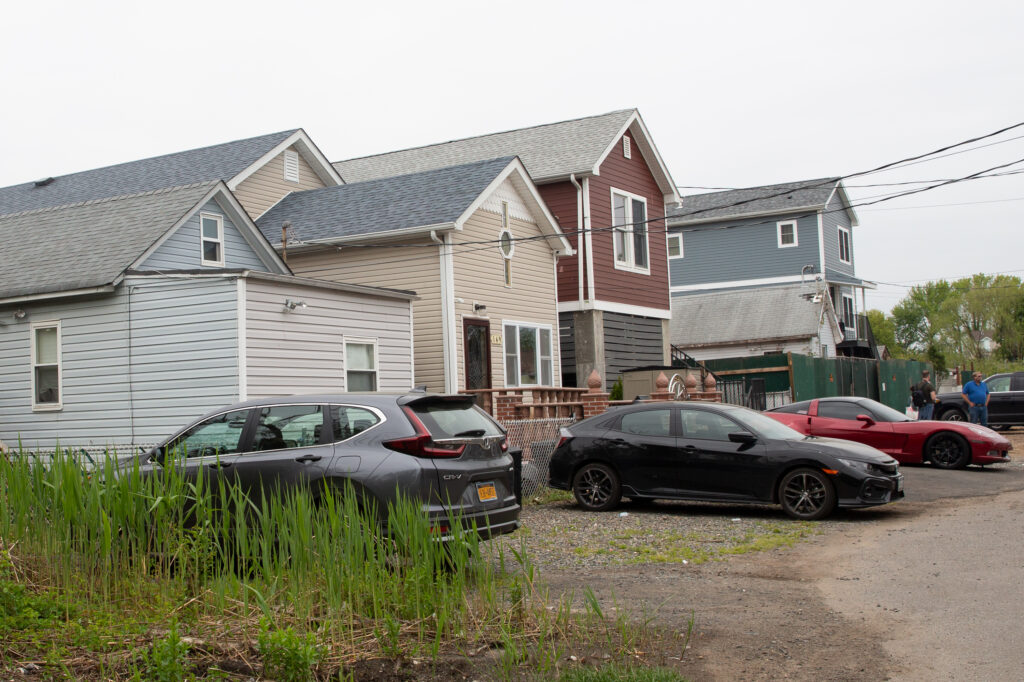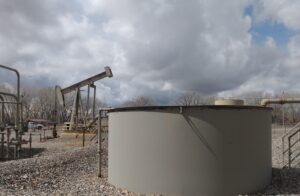A Staten Island Study in Rebounding Post-Sandy
7 min read
A single block in Staten Island is now a serendipitous showcase for three approaches to rebuilding and living in flood-prone areas devastated by Hurricane Sandy in 2012.
The owner of the first house rebuilt it as it was.
The owner of the second house put it on stilts a story high.
And on Monday, the third house was knocked down in order for its land to be returned to nature.
“It’s like the three little pigs,” said Greg Jacob, senior policy advisor for The Nature Conservancy, which is working with the federal government to demolish the home and restore the land. “I guess we’ll see [what happens] when the next storm hits.”
On a block of Freeborn Street in the Midland Beach neighborhood, rebuilding from Sandy continues even nearly a decade after the storm, and it can look a lot like destruction.
There, elevated vinyl-sided homes are wedged next to bungalows that remain on the ground. New, raised single- and multi- family homes developed more recently also dot the street, as do some decrepit houses, abandoned or awaiting renovation.
In places at high risk of flooding, city, state and federal governments are confronted with a choice: they can protect residents and their property, or move people away from climate risks.
In places like Midland Beach, homeowners had both options.
The demolished home on Freeborn Street was one of 11 properties in the neighborhood that the U.S. Department of Agriculture’s Natural Resources Conservation Service acquired post-Sandy — along with six empty lots — as part of a program to restore and protect the island’s floodplain, in partnership with The Nature Conservancy.
The land on which the home stood, along with the adjacent vacant lot and a reclaimed parcel a block east, will become part of the New Creek Bluebelt.
The Bluebelt is what the city calls a green infrastructure project that enhances a natural watershed in order to manage stormwater. There are 89 bluebelts citywide.
Five of the other Staten Island parcels bought by the feds will go to the city Department of Parks and Recreation, and nine will go to the Department of Citywide Administrative Services. Those parcels will remain as open space, according to spokespeople from both agencies.
Conceding to the Flood
The property demolished this week on Freeborn Street once belonged to Joseph Davis, who bought the one-story bungalow in 1990 and now lives in Pennsylvania.
Hurricane Sandy destroyed the home, with water going nearly 12 feet high. All the family’s possessions were lost, with only items stored in plastic containers in the attic remaining dry, he said.
Davis and his family first tried to navigate the process of rebuilding their home through the city’s Build It Back program, which assisted in recovery for victims of the storm and constructed elevated homes.
Build It Back was widely criticized for being steeped in delays, confusion and bureaucracy. But the rebuilding process proved especially difficult for the Davis family because they also attempted to rebuild their home so it would be wheelchair-accessible, Davis and his daughter April said.
Fed up with the complicated permitting process and facing high expenses, the family began considering a buyout offer from the federal Natural Resources Conservation Service.
“They’ll buy the property as is and give me the price before the storm,” Davis said, describing the offer. Davis got paid in 2017, the same year the city completed the first phase of the New Creek Bluebelt, which will eventually encompass nearly 100 acres.
Five years later, after a series of delays, Davis’ property was demolished earlier this week. All the others acquired through this mechanism have been demolished too, or will be by the end of June, officials say.
The Nature Conservancy and NRCS will clear the area, slope the land down to the creek and plant a native plant seed mix on top before handing over the parcel to the Department of Environmental Protection.
“I think it’s gonna be beautiful for the people still living there,” April said. “Hopefully they’ll have a better stormwater system for future flooding, God forbid something like Sandy happens again.”
The parcels will become incorporated into the wider Bluebelt, acting as buffers for residents and providing places for stormwater to go.
On Freeborn Street and in the wider neighborhood, the greenery surrounding the Bluebelt is lush, with geese and the occasional turkey wandering among the shrubs, trees, wildflowers and reeds.
The project improves the flow to New Creek, which snakes through the neighborhood, in order to clean the water before it hits the ocean. A series of meandering streams empty into man-made pools, where the water levels can be regulated using weirs, or small dams that can control the movement of water.
The Bluebelt also retains stormwater and provides space for additional flooding. Plus, it should help keep pressure off the Army Corps of Engineers’ forthcoming 5.3-mile seawall, which will run along Staten Island’s eastern shore from Fort Wadsworth to Oakwood Beach.
“What you’re looking at is a system,” said Peter Gibbs, conservation easements program manager at NRCS. “Even though this is highly developed, if you get a huge event, like a hurricane or maybe some crazy rain, this is the floodplain. The idea behind our program is to enhance that system so that it can handle the floods.”
Patchwork Options
It can be contradictory to see both buyouts and reconstructions on the same block, but generally it’s up to homeowners to choose what happens to their properties. The government rarely opts for eminent domain, a politically and practically thorny approach, which can allow the seizure of private property for public good.
On Freeborn, Nicole Giglio lives in a red one-story house that was elevated after Sandy. Her father has owned the property for about 30 years, she said.
“They gave him two options: You can either sell — we’ll buy the land from you, and then they were gonna do what they’re gonna do to that house — or we’ll build you back a house,” Giglio, 29, said. “He chose to build the house. It took a really long time, though.”
The new house wasn’t finished until 2018, she said.
“What you’re seeing there on that block is basically the product of this ‘every household for itself’ sort of policy for protecting property,” said Thaddeus Pawlowski, managing director of the Center for Resilient Cities and Landscapes at Columbia University. He also worked in the Mayor’s Office of Housing Recovery Operations after Sandy. “How do we address not just the environmental issues here…but have a coherent community plan that lifts everybody up?”
Pawlowski called the bluebelts “part of the catalytic transformation needed,” an example of how he’d like to see public investment in comprehensive adaptation. Without that, Pawlowski foresees future disasters that will worsen inequality.
Gibbs noted the every-homeowner-for-themselves policy proved tricky for duplexes that had been offered buyouts, if an owner on one side agreed to take it and another didn’t want to. In those cases, NRCS wasn’t able to acquire the land, limiting how much of the marsh could be restored.
Just about two miles south of Midland Beach, a group of Oakwood Beach residents came together after Sandy and convinced the state to buy them out with funds from the federal Department of Housing and Urban Development. Graham Beach and Ocean Breeze were also eligible for these buyouts, which occurred separately from the NRCS’ floodplain easement program.
“They were able to demolish way more, and that’s what we would like,” Gibbs said.
Staying on the Ground
While the Bluebelt isn’t doesn’t cover the entire neighborhood, it makes the remaining buildings in the area less susceptible to damage as a result of flooding and the next storm.
It has already benefited the neighbors on Freeborn Street, including those who moved into brand new houses built after Sandy.
One homeowner on the block said she appreciated the Bluebelt’s nature, and she and her family would walk into the trails beyond the street during the thick of the pandemic.
“It’s very beautiful for you to go look at and whatnot. It’s very nice over there,” she said. “We’d drop a fishing pole just for fun and put the fish back. You could catch pretty big catfish in there. There’s nice birds, blue herons and egrets.”
The woman, who works as a dog groomer, didn’t want to move her family after Sandy. She loves the relative quiet and the way she could see fireworks on the beach from her one-story house.
Her federal flood insurance only allowed her to rebuild her house in the same way it was before the storm. She couldn’t afford to elevate it. Now, her roof barely reaches the first floor of an elevated house down the street.
She’s lived on the block for nearly two decades — just a few lots from the Davis family — and said the street used to flood frequently. If she knew rain was forecast, she’d park her car away from the house on higher ground.
“The creek would overflow and you’d be to the knees in water — not enough to get in the house, but enough to inconvenience you,” she said. “But after they did this [Bluebelt work], this redoing of back down there, the flooding kind of subsided.”
When the remnants of Hurricane Ida hit, the water level only made it to the level of the curb, she and another neighbor noted.
“We’re moving people out of harm’s way,” said Jacob, of The Nature Conservancy, “and providing a more resilient community for the people that decide to stay.”
This article was originally posted on A Staten Island Study in Rebounding Post-Sandy






